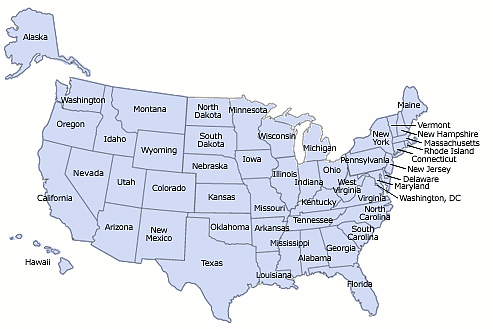
The States, Districts and Territories of the U.S.A.
Washington D.C. is a federal district under the authority of Congress. Puerto Rico is a commonwealth associated with the United States. Other dependent areas include American Samoa, Baker Island, Guam, Howland Island, Jarvis Island, Johnston Atoll, Kingman Reef, Midway Islands, Navassa Island, Palmyra Atoll, Virgin Islands, Wake Island. From 18 July 1947 until 1 October 1994, the US administered the Trust Territory of the Pacific Islands, but recently entered into a new political relationship with all four political units: the Northern Mariana Islands is a commonwealth in political union with the US (effective 3 November 1986); Palau concluded a Compact of Free Association with the US (effective 1 October 1994); the Federated States of Micronesia signed a Compact of Free Association with the US (effective 3 November 1986); the Republic of the Marshall Islands signed a Compact of Free Association with the US (effective 21 October 1986).
In general, matters that lie entirely within state borders are the exclusive concern of state governments. These include internal communications; regulations relating to property, industry, business, and public utilities; the state criminal code; and working conditions within the state. There are many areas of overlap between state and federal jurisdictions. In recent years, the federal government has assumed broader responsibility in such matters as health, education, welfare, transportation, and housing and urban development. The constitutions of the various states differ in some details but generally follow a pattern similar to that of the federal Constitution, including a statement of the rights of the people and a plan for organizing the government. On such matters as the operation of businesses, banks, public utilities, and charitable institutions, state constitutions are often more detailed and explicit than the federal constitution.